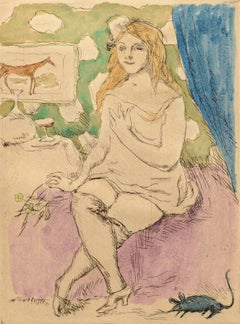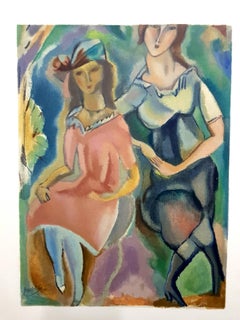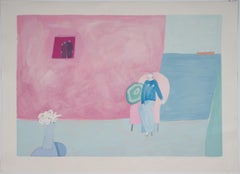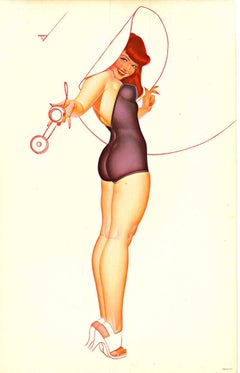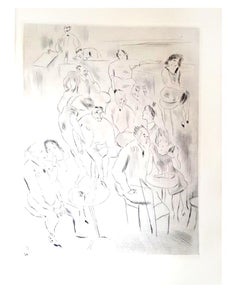Jules Pascin Portrait Prints
Bulgarian, French, 1885-1930
Jules Pascin was born Julius Mordecai Pincas, in Widdin, Bulgaria to a Spanish-Sephardic Jewish father and a Serbian-Italian mother. His early artistic training was in Vienna and Munich. In 1905, at the age of 20, he adopted the pseudonym Pascin (an anagram of Pincas). About the same time, he began contributing drawings to Simplicissimus, a satirical magazine published in Munich.
In December 1905, Pascin moved to Paris, becoming part of the great migration of artists to that city at the start of the 20th century. In 1907, Pascin met Hermine Lionette Cartan David, also a painter, and they became lovers. They lived together until Pascin left for America on October 3, 1914. A few weeks later on October 31, Hermine David sailed for the United States to join Pascin.
Pascin lived in the United States from 1914 to 1920, sitting out World War I. He taught at the Telfair Academy in Savannah, Georgia, associated with the Telfair Art Museum. He and Hermine painted in New York City as well as in Miami, New Orleans, and Cuba.
Despite his social life, Pascin created thousands of watercolors and sketches, plus drawings and caricatures, which he sold to various newspapers and magazines. He studied the art of drawing at the Académie Colarossi and, like Henri de Toulouse-Lautrec, he drew upon his surroundings and his friends, both male and female, as subjects. He wanted to become a serious painter, but in time, he became deeply depressed over his inability to achieve critical success with his efforts.
During the 1920s, Pascin mostly painted fragile petites filles, prostitutes waiting for clients, or models waiting for the sitting to end. His fleetingly rendered paintings sold readily, but the money he made was quickly spent. Famous as the host of numerous large parties in his flat, whenever he was invited elsewhere for dinner, he arrived with as many bottles of wine as he could carry. He frequently led a large group of friends on summer picnics beside the River Marne, where their excursions lasted all afternoon.
Ernest Hemingway's chapter titled "With Pascin At the Dôme," in A Moveable Feast, recounted a night in 1923 when he had stopped off at Le Dôme and met Pascin escorted by two models. Hemingway's portrayal of the evening is considered one of the defining images of Montparnasse at the time.
Pascin struggled with depression and alcoholism. "[D]riven to the wall by his own legend," according to art critic Gaston Diehl, he committed suicide at the age of 45 on the eve of a prestigious solo show. He slit his wrists and hung himself in his studio in Montmartre. On the wall he left a message written in blood, to a former lover, Cecile (Lucy) Vidil Krohg In his last will and testament, Pascin left his estate equally to his wife, Hermine David, and his mistress Lucy Krohg.to
2
Overall Width
to
Overall Height
to
2
22
267
171
117
87
2
1
1
2
2
2
1
1
1
1
1
1
1
Artist: Jules Pascin
"Dame de la Nuit, " Jules Pascin, hand-colored etching, 1920-30, figurative
By Jules Pascin
Located in Wiscasset, ME
Born Julius Pincas in 1885 in Bulgaria, the artist adopted the name Jules Pascin under which his paintings are known. Pascin studied in Vienna and Munich, and traveled and painted regularly in Paris and Berlin. Pascin came to the United States in 1914 and in 1920 became a US citizen. He returned later...
Category
1920s Modern Jules Pascin Portrait Prints
Materials
Etching
Femininity - Lithograph
By Jules Pascin
Located in Collonge Bellerive, Geneve, CH
(after) Jules Pascin
Title: Femininity
Signed in the plate
Dimensions: 38 x 28 cm
from the edition of 250 as issued in Warnod, Andre, "Les Peintres mes amis" (Paris: Les Heures Claires, 1965)
Jules Pascin, born Julius Mordechai Pincas, was a Bulgarian Jewish painter sometimes referred to as "the Prince of Montparnasse."
He was born on March 31, 1885 in Vidin, Bulgaria to a Spanish-Sephardic Jewish father and a Serbian-Italian mother, the eighth of eleven children. The Pincas family moved to Bucharest, Romania in 1892 and Pascin was raised there until he left for boarding school in Vienna in 1896.
While briefly working for his father’s grain merchant firm in Bucharest at fifteen, Pascin spent much of his time completing his earliest drawings in the local bordello, where he was residing under the Madame’s protection. In 1902, at the age of seventeen, Pascin moved to Vienna to study painting. The next year, he studied at the Heymann Art School in Munich. There, he supported himself by selling satirical drawings to Simplicissimus and other German magazines. Pascin would contribute drawings to a Munich daily through 1929.
Pascin’s contributions were widely recognized for their wit and insight, and upon his arrival in Paris in 1905 he was welcomed at the Gare Montparnasse by an international group of artists and writers who gathered at the Café du Dôme, which Pascin soon began to frequent regularly. The group included Grossman, Grosz, William Howard, Levy, and Emil Orlik. Pascin was also a close friend of Amadeo Modigliani.
Upon his arrival in Paris, Julius Mordechai Pincas changed his name to Jules Pascin and soon became the symbol of the Montparnasse artist community. Always in his bowler hat, he was a witty presence at Le Dôme café, Le Jockey club, and the others haunts of the area’s bohemian society, and was known for hosting legendary all-night parties. In his story, A Moveable Feast, Ernest Hemingway wrote a chapter titled With Pascin At the Dôme, recounting a night in 1923 when he had stopped off at Le Dôme and met Pascin escorted by two models. Hemingway's depiction of the events of that night is considered one of the defining images of Montparnasse at the time.
In 1907, Pascin had his first solo exhibition at Paul Cassirer Gallery in Berlin. Three years later, Cassirir commissioned Pascin to illustrate Heinrich Heine's Aus den Memoiren des Herrn von Schnabelewopski. In 1911, Pascin exhibited his work at Berlin Secession and a year later at the Sonderbund-Aussstellung in Cologne. The artist’s first exhibition in the United States was at the Armory Show in New York, where he exhibited twelve of his works.
Upon the outbreak of World War I, Pascin left Paris for London in order to avoid conscription in the Bulgarian Army. In October 1914, he immigrated to New York, where he stayed through 1920 and would later return again in 1927. Pascin was immediately welcomed into an artists circle based around the Penguin Club and became acquainted with John Quinn, an important art collector. A short time after his arrival in New York, Pascin was given a one-man show by the Berlin Photographic Company, a Madison Avenue gallery. While in New York, Pascin became associated with several progressive painters, including Walt Kuhn, Yasuo Kuniyoshi, and Max Weber. Many of these painters were influenced by Pascin’s unique style, in which he combined elements from Expressionism and Cubism with his own personal view of his environment.
Pascin used his time in the United States to travel extensively, especially in the southern states and the Caribbean islands, recording his travels in sketches that were widely acclaimed. Pascin married Hermine David in 1918. In 1920, Pascin was awarded American citizenship with support from Alfred Stieglitz and Maurice Sterne. He returned to Paris in October of that same year and met his future mistress, Lucy Krohg, the wife of the Norwegian painter Per Krohg...
Category
1960s Modern Jules Pascin Portrait Prints
Materials
Lithograph
Related Items
Unframed "Seated Woman on Pink Chair" signed lithograph by artist Joy Laville
By Joy Laville
Located in Boca Raton, FL
Unframed "Seated Woman on Pink Chair" lithograph by artist Joy Laville. Signed H J Laville lower right recto. Image size: 31 x 43 inches.
Category
1980s Modern Jules Pascin Portrait Prints
Materials
Lithograph
Original Pin-Up - Telephone Call linen backed vintage pinup girl.
Located in Spokane, WA
Behold the original lithographic Petty Pin-up, a unique vertical-format piece. The see-through bathing suit she wears seems to make her glow, especially with her red hair peeking fro...
Category
1940s American Modern Jules Pascin Portrait Prints
Materials
Lithograph
$598
H 19 in W 12.25 in D 0.05 in
Original Americans All! Honor Roll - Victory Libery Loan vintage poster
By Howard Chandler Christy
Located in Spokane, WA
Original 1919 Vintage "Americans All!" Victory Liberty Loan Poster by Howard Chandler Christy. Archival linen backed in A- condition, ready to frame.
This iconic 1919 "American...
Category
1910s American Modern Jules Pascin Portrait Prints
Materials
Lithograph
Howard Chandler ChristyOriginal Americans All! Honor Roll - Victory Libery Loan vintage poster, 1919
$759 Sale Price
22% Off
H 40 in W 26.75 in D 0.05 in
Catherina Dorothea Viehmann David Hockney Fairy Tales from the Brothers Grimm
By David Hockney
Located in New York, NY
The frontispiece for Hockney’s Six Fairy Tales from the Brothers Grimm portfolio and book features Catherina Dorothea Viehmann, the elderly German woman who recounted fairy tales to ...
Category
1960s Modern Jules Pascin Portrait Prints
Materials
Etching, Aquatint
$850
H 24.75 in W 17.75 in
Pablo Picasso - Le Vieux Roi (The Old King), original lithograph
By Pablo Picasso
Located in London, GB
Pablo Picasso
Le Vieux Roi (The Old King) Seigneur et deux filles, 1959
Original Lithograph on Arches light paper with Mourlot watermark,
signed in the stone with a red signature.
p...
Category
1950s Modern Jules Pascin Portrait Prints
Materials
Lithograph
$2,163 Sale Price
20% Off
H 31.5 in W 23.63 in
The Search
By Alberto Giacometti
Located in London, GB
Alberto Giacometti
The Search , ca. 1968
Restrike Etching
unsigned
comes with COA from publishers
25.4 × 20.3 cm
51 x 40.5 cm (framed)
Category
1960s Modern Jules Pascin Portrait Prints
Materials
Lithograph
Vintage SIGNED Kitaj Poster, La Fabbrica, Milan (A Life 1975) woman in red dress
By Ronald Brooks Kitaj
Located in New York, NY
Printed in 1975, this poster features the encounter between an alluring woman dressed in red, and a man with his back to the viewer. The light of a streetlamp is beautifully imitated...
Category
Late 20th Century Modern Jules Pascin Portrait Prints
Materials
Lithograph
Original Vetements Forchic French fashion vintage poster
Located in Spokane, WA
Original lithograph, linen backed. Vetements Forchic. Pour Lui; Elle a Choise. Archival linen-backed vintage French fashion poster in fine...
Category
1940s American Modern Jules Pascin Portrait Prints
Materials
Lithograph
$1,000 Sale Price
20% Off
H 61 in W 44.25 in D 0.05 in
The Princess in her tower David Hockney Six Fairy Tales from the Brothers Grimm
By David Hockney
Located in New York, NY
One of David Hockney’s Six Fairy Tales from the Brothers Grimm illustrations, taken from the story of ‘The Little Sea Hare’. This tower was likely inspired by Hockney’s travels throu...
Category
1960s Modern Jules Pascin Portrait Prints
Materials
Etching, Aquatint
$2,000
H 24.75 in W 17.75 in
Collaborative Etching With 6 artist Hand Signed by 3 artists inc. Dorothy Dehner
By Adolph Gottlieb
Located in New York, NY
Adolph Gottlieb, David Smith, Dorothy Dehner, Edgar Levy, Lucille Corcos and Esther Gottlieb
Collaborative Etching With 6 artist (Hand Signed by 3 artist), ...
Category
Mid-20th Century Modern Jules Pascin Portrait Prints
Materials
Etching
$5,000
H 14.25 in W 12.75 in D 0.4 in
Original 'Apollo Stumpen' vintage Swiss cigar poster
By Johannes Handschin
Located in Spokane, WA
Original Swiss poster: Apollo Stumpen Cigars. Johannes Handschin created this Swiss poster. Swiss size of 35" x 49". Professional acid-free archival linen backed, ready to frame. The colors are vibrant and intense. Great colors. Rare original Swiss (Switzerland) vintage poster.
This is the rarer large format, the rarest version of the poster. The small format is 20 x 27, about 1/2 the size.
There is a flaw in the lower section of the man’s covering, the lower left of his chin. Shown in images.
Switzerland was known for some of the better printing of their posters and the use of more expensive inks, thus richer colors in the posters that survive today.
This art deco-style cigar poster...
Category
1940s American Modern Jules Pascin Portrait Prints
Materials
Lithograph
$760 Sale Price
20% Off
H 49 in W 35 in D 0.05 in
The Princess after many years in the Glass Mountain by David Hockney fairy tale
By David Hockney
Located in New York, NY
This etching from David Hockney’s celebrated Six Fairy Tales from the Brothers Grimm portfolio depicts the somewhat obscure story Old Rinkrank, which Hockney chose to illustrate beca...
Category
1960s Modern Jules Pascin Portrait Prints
Materials
Etching, Aquatint
$1,100
H 24.75 in W 17.75 in
Previously Available Items
Jules Pascin - Au Bal - Original Etching
By Jules Pascin
Located in Collonge Bellerive, Geneve, CH
Jules Pascin - Au Bal - Original Etching
Dimensions : 13 x 10".
Paper : Rives vellum.
Edition : 225 copies.
1927
From Tableaux de Paris, Emile-Paul Freres, Paris
Jules Pascin, born Julius Mordechai Pincas, was a Bulgarian Jewish painter sometimes referred to as "the Prince of Montparnasse."
He was born on March 31, 1885 in Vidin, Bulgaria to a Spanish-Sephardic Jewish father and a Serbian-Italian mother, the eighth of eleven children. The Pincas family moved to Bucharest, Romania in 1892 and Pascin was raised there until he left for boarding school in Vienna in 1896.
While briefly working for his father’s grain merchant firm in Bucharest at fifteen, Pascin spent much of his time completing his earliest drawings in the local bordello, where he was residing under the Madame’s protection. In 1902, at the age of seventeen, Pascin moved to Vienna to study painting. The next year, he studied at the Heymann Art School in Munich. There, he supported himself by selling satirical drawings to Simplicissimus and other German magazines. Pascin would contribute drawings to a Munich daily through 1929.
Pascin’s contributions were widely recognized for their wit and insight, and upon his arrival in Paris in 1905 he was welcomed at the Gare Montparnasse by an international group of artists and writers who gathered at the Café du Dôme, which Pascin soon began to frequent regularly. The group included Grossman, Grosz, William Howard, Levy, and Emil Orlik. Pascin was also a close friend of Amadeo Modigliani.
Upon his arrival in Paris, Julius Mordechai Pincas changed his name to Jules Pascin and soon became the symbol of the Montparnasse artist community. Always in his bowler hat, he was a witty presence at Le Dôme café, Le Jockey club, and the others haunts of the area’s bohemian society, and was known for hosting legendary all-night parties. In his story, A Moveable Feast, Ernest Hemingway wrote a chapter titled With Pascin At the Dôme, recounting a night in 1923 when he had stopped off at Le Dôme and met Pascin escorted by two models. Hemingway's depiction of the events of that night is considered one of the defining images of Montparnasse at the time.
In 1907, Pascin had his first solo exhibition at Paul Cassirer Gallery in Berlin. Three years later, Cassirir commissioned Pascin to illustrate Heinrich Heine's Aus den Memoiren des Herrn von Schnabelewopski. In 1911, Pascin exhibited his work at Berlin Secession and a year later at the Sonderbund-Aussstellung in Cologne. The artist’s first exhibition in the United States was at the Armory Show in New York, where he exhibited twelve of his works.
Upon the outbreak of World War I, Pascin left Paris for London in order to avoid conscription in the Bulgarian Army. In October 1914, he immigrated to New York, where he stayed through 1920 and would later return again in 1927. Pascin was immediately welcomed into an artists circle based around the Penguin Club and became acquainted with John Quinn, an important art collector. A short time after his arrival in New York, Pascin was given a one-man show by the Berlin Photographic Company, a Madison Avenue gallery. While in New York, Pascin became associated with several progressive painters, including Walt Kuhn, Yasuo Kuniyoshi, and Max Weber. Many of these painters were influenced by Pascin’s unique style, in which he combined elements from Expressionism and Cubism with his own personal view of his environment.
Pascin used his time in the United States to travel extensively, especially in the southern states and the Caribbean islands, recording his travels in sketches that were widely acclaimed. Pascin married Hermine David in 1918. In 1920, Pascin was awarded American citizenship with support from Alfred Stieglitz and Maurice Sterne. He returned to Paris in October of that same year and met his future mistress, Lucy Krohg, the wife of the Norwegian painter Per Krohg...
Category
1920s Modern Jules Pascin Portrait Prints
Materials
Etching
Jules Pascin portrait prints for sale on 1stDibs.
Find a wide variety of authentic Jules Pascin portrait prints available for sale on 1stDibs. You can also browse by medium to find art by Jules Pascin in etching, lithograph and more. Much of the original work by this artist or collective was created during the 20th century and is mostly associated with the modern style. Not every interior allows for large Jules Pascin portrait prints, so small editions measuring 4 inches across are available. Customers who are interested in this artist might also find the work of Gerald Leslie Brockhurst, John Sloan, and Georges Rouault. Jules Pascin portrait prints prices can differ depending upon medium, time period and other attributes. On 1stDibs, the price for these items starts at $1,621 and tops out at $2,500, while the average work can sell for $2,060.
